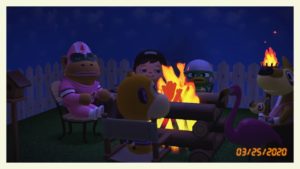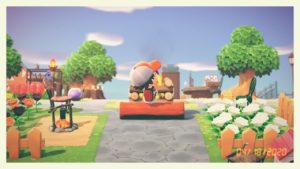Welcome to the cKotch.Com blog. I’m Christopher Kotcher, and this is Game Story. Time to discover lessons in writing found in gaming.

Rolling into Town
All kinds of games have grabbed my interest through the years. This is one series that took a while.
One fine day, likely a birthday, holiday, or some other occasion, my parents got me a little game called Animal Crossing for my Nintendo GameCube.
The younger me knew little about this game. There were some funny commercials on TV and a few brief articles in the Nintendo Power magazine.
They all talked about living a life in a small town filled with animals. The big selling point was the game’s real-time clock, which matched the in-game time to the actual time.
I started the game and found my character riding on a train. A blue cat named Rover sat across from me. He was going to set me up with an old friend to get me a house.
The old friend turned out to be a racoon named Tom Nook. He gave me a little house and outstanding mortgage. Then he employed me to deliver items to villagers to pay him off.
That was essentially the whole game right there.
Talk to villagers. Fish. Catch bugs. Dig up fossils. Buy and sell items. Pay off debt. Enjoy a few holidays and weekly and monthly events here and there. Repeat until done.
That wasn’t much of a game to my younger self. If anything, this was a collection of side quests, the little chores you do in between a game’s defining moments.
Keeping the game at my grandma’s house didn’t help much either. Most of my chances to play came late at night or early in the morning when the in-game stores were closed.
Yes, the stores in this game closed at night, all thanks to that real-time clock.
My gaming focus was back on Super Mario: Sunshine, Metroid Prime, and Legend of Zelda: The Wind Waker in no time flat. Those were the real classics to me.
I never thought I’d touch another Animal Crossing game again, if they ever even made anymore.
The Happy Hype Cycle
Animal Crossing went on to become one of Nintendo’s best-selling series. Nearly every Nintendo system after the GameCube received an entry to call its own.
These games never grabbed my attention. After my experience with the first one, I didn’t understand the appeal.
Wild World’s portability meant little to me. City Folk’s bustling city didn’t impress me. Being the town mayor in New Leaf was intriguing, but my mind had already been made up on the series.
Then came the pre-release hype cycle for the Nintendo Switch entry Animal Crossing: New Horizons. I was suddenly clamoring for the game alongside the diehard fans.
How did that happen?
For one, I now had a lot more exposure to the series.
The series’ characters and items began appearing in other games I played, like Super Smash Bros. and Mario Kart. The world of Animal Crossing became familiar to me.
Friends in college carried the Nintendo 3DS entry Animal Crossing: New Leaf wherever they went. I saw firsthand how much they cared about the game.
Game journalists on YouTube went nuts over their love for the series. The anticipation for the next game grew to excite me.
Everything culminated in the big reveal trailer for New Horizons.
The game would now be set on an island. While previous games made you a villager and a mayor, this game would see you build a town.
Homes and islands alike could be decorated with all kinds of crafts and furniture. The place could be whatever I wanted it to be. Even rivers could be moved and cliffs reduced to rubble.
This game wanted to give me simple joy. It wanted to be a place for me to make my own.
I didn’t fully understand why, but that prospect pushed me to grab my first Animal Crossing game since the original.
Joys of Island Life

The island of BoxerHouse was created on March 20, 2020, in Animal Crossing: New Horizons.
My character moved there the same day alongside a sisterly superhero gorilla named Rocket and a sporty swimmer of a duck named Scoot.
Tom Nook got me for another massive debt even though my character lived in a mere tent. Apparently, airfare and phone bills were all charged to him now.
This time, however, Nook didn’t employ me to run errands. He made me his partner in building up the island. He wanted to turn the place into a proper town and tourist destination.
There was actually somewhat of a story this time around beyond pay off debt.
Everything ultimately comes back to building up the island.
Bringing in new animal villagers allows the community to grow. They make the place lively, strolling around, catching bugs, fishing, and lounging about.
Gathering supplies and raw materials lets me build furniture, fencing, and even shops and buildings.
Fishing, catching bugs, and digging up fossils creates and sustains an island museum. Culture and knowledge both come to the once-deserted island.
All these actions also build up in-game money and reward miles. These in turn allow me to make and grab more items to build up the island and earn more in-game money and miles.
Honestly, this is one of the best loops I’ve ever seen in a game. Every reward presented to me enables me to do something more in the game.
The real-time clock’s still a thing, but now there’s always something to do, even if the stores are closed. There are always items to craft, villagers to greet, and museum donations to make.
Plus, that clock ensures holidays and other events come to the island, always keeping me fresh and inviting back, even as I would move to other games.
Over time, Tom Nook’s tale fades into the background. He settles into an easy administrative life in the Resident Services building. Further development of the island has been left entirely in my hands.

Takeaways from the Castaways
New Horizons really does have to have one of the most intriguing uses of story in a videogame.
Most single-player games use the story to push you to the end of the game. You beat the final boss, see the credits roll, and you’re done.
Sometimes, you get a post-game where you do some extra things now that the world’s saved. You may even face some kind of super boss after the main tale’s final boss.
In the end, it’s simply extra story, really an epilogue or extended post-credits scene.
Many competitive multiplayer games use a separate story mode to train you how to play against other players. The story is a mere means to an end.
New Horizons starts you with a simple story of a racoon who wants to build a town on a deserted island. It leaves that story’s continuation in your hands. It only has to end when you want it to.
Honestly, New Horizons has made me realize what I suppose all Animal Crossing story are really about.
They are exercises in imagination. They give you basic tools and elements of a world then let you make whatever you want. The story is yours to shape according to the tools presented to you.
I have to say that these features actually speak to my passions as a writer. The whole craft is built on using words to build worlds to be visited and stories to live in them.
In New Horizons, I now find a game which gives me the chance to relax and unwind while still flexing those creative muscles. The possibilities appear endless.
Discussion Time!
The younger me probably would’ve never expected it, but I guess I can now wholeheartedly call myself an Animal Crossing fan!
Have you played the games? What do you think of them? Does my experience with the latest game get you interested in them?
Also, what do you think of my take on the unique story aspects of Animal Crossing? Do you see where I’m coming from? Or am I clearly being paid off by Tom Nook?
Kotcher’s Call to Action
If you like my content and wish to see more, you could check out my books Five Strange Stories and Good Stuff: 50 Poems from Youth on Amazon. They are enrolled in the Kindle Matchbook program, so anyone who buys the paperbacks can also get the eBooks for free.
Finally, be sure to like my Facebook page and share it with your friends. I post a link there whenever a new blog post goes live each Friday at 5:00 PM EST.